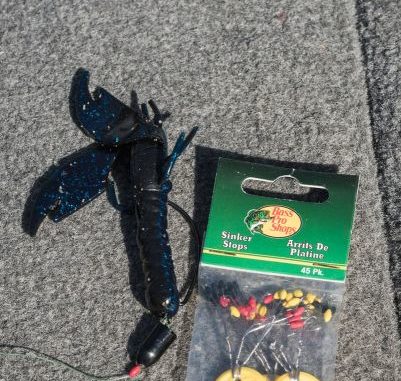
Stoppers keep bass weights in place, wires can be used to thread line
I was working a craw worm away from the bank for the thousandth time. The only thing different was that my line jumped, and I felt a bit of weight on the terminal end.
I reeled down and set the hook hard, confident I’d be fighting my first bass of the day.
But the 30-pound braided line snapped immediately.
Either it was a really nice bass. Or the age of the line (I’m not one to change line unless absolutely forced) manifested itself with the breakage.
I’m going with the story that I missed a huge bass.
In any case, I was left to sit down and rerig.
Tungsten is my current weight of choice, so I dug out a 1/4-ounce bullet weight, a 3/0 offset hook and another craw.
I asked Austin Abadie if he had a peg, so I could keep the weight from running up and down the line. The rubber pegs I had in my bag were too large to fit through the weight’s opening, even without the line.
“That’s all I have,” he said. “But have you tried a bobber stopper?”
As in those things you use when bream or crappie fishing? Yep, that’s exactly what he offered.
“You can get a few dozen for $2 at Bass Pro Shops,” Abadie said. “When I punch grass, I use two —you’re going to run through the first one, and then you’ll still have one on the line so you don’t have to retie.”
The little packet of Bass Pro Shops Sinker Stoppers are simply small rubber tubes on little wires.
I grabbed one of the tabs, around which several stoppers were arrayed, threaded my line through the wire and pulled the wire and line through the stopper.
The stopper could be moved up and down the small-diameter braid fairly easy, but there was enough resistance to hold a weight in place.
Awesome, I thought.
Until I tried threading my line through the sinker’s hole — a tiny opening I could barely make out. I mean, dang, folks, couldn’t that hole be made a tad larger?
My old eyes had a hard time making out the opening, even when I extended my arms to full length. And even when I figured out where to put the line, the limber braid just curled up. On the outside of the weight.
After what felt like 30 minutes, I complained to Abadie. Who looked sympathetic but never missed a beat in his rhythm of pitches.
I was gnashing my teeth and thinking bad things about all weight manufacturers, when a thought struck me.
I grabbed that tab of bobber stoppers, selected an empty wire and pushed it through the bottom end of the weight.
The wire poked out the top end, and I pushed the braid through the opening at the end of the wire. Then I simply pulled the wire back through the weight.
My line was now threaded onto the weight, and all I had to do was tie on my hook, thread on the plastic lure and set my bobber stopper.
I was ready to go.


